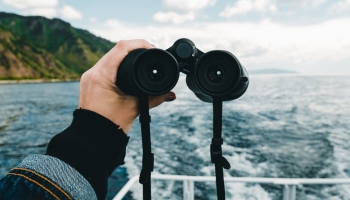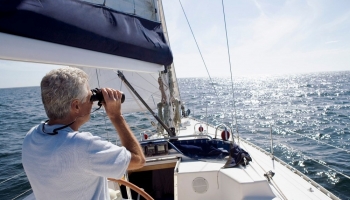Best Binoculars for Hiking
Five Binoculars for Helping You Connect with Nature

It’s great to leave the four walls behind and really immerse yourself in nature on a nice long hike from time to time. But do you ever feel that no matter how lost you get on the mountains, and in the forests and meadows, the exciting things are always happening in the distance?
There could be a parcel of deer prancing majestically over a hill, but to you, they’re just a vague blur of black dots moving among the greenery. There could be a rare bird of prey wheeling in the wind, but from this distance, it might as well be a pigeon. If, as I was, you’re sick of missing out on these special moments, you’ll need to invest in some binoculars.
Not just any will do, though. You should always buy binoculars to suit the intended application, which in this case, is hiking. Don’t worry if you don’t know where to start. Having already done the research myself, I’m happy to pass on what I learned to you here today.
Best Binoculars for Hiking – Reviews
You’re losing valuable daylight here that could otherwise be enjoyed on a lovely hike, so let’s jump straight into some reviews.
Top Pick
Leica Ultravid 8×32 HD Plus Binoculars
Leica makes some of the highest-quality cameras in the world, so it stands to reason that they’d produce an amazing pair of binoculars too.
I’d consider 8×32 the perfect catch-all magnification and aperture combo for hiking. It offers both a detailed view of distant scenes and objects, and superb light transmission without being excessively bulky.
On the contrary, these binoculars are rather compact, fitting in the average fast-access side pocket of a pack. As soon as you see something stir in the distance, you can quick-draw the Ultravids wild west style and see what’s up.
The lenses have been treated with Leica’s proprietary AquaDura coating that guarantees image acuity no matter the weather. The whole design is completely waterproof.
Keeping all the state-of-the-art optics safe and sound is a lightweight yet incredibly durable magnesium chassis, ensuring the Ultravids won’t slow you down or fail you when the terrain gets a little challenging — perfect!
Pros
- Compact and Lightweight – They don’t impose.
- State of the Art 8×32 Optics – The best money can buy.
- Weatherproof – Don’t worry about getting caught in the rain.
- Durable – Rugged magnesium chassis can handle life on the trail.
- Roof Prisms – Tougher than porro
Cons
- Price – These are extremely expensive binos.
Second Pick
Zeiss Conquest Binoculars
With 8x magnification and a 32mm aperture, the Conquests offer you the same glorious view of the landscape as my top Leica pick. They’re powerful enough to explore the finite details of distant scenery without compromising image stability, and the scene will always appear airy and bright.
Furthermore, boasting an HD lens, glassed images are never anything short of breathtaking. Sure, the high-tech optics mean the price goes up into the stratosphere, but these things are so well-made, they’ll last a lifetime.
If I’m being picky, I’d prefer it if they were smaller. At 6” x 6” x 4”, they’re not exactly pack-friendly, so you’d have to wear them around your neck or invest in some sort of special holster.
The good news is that their Lotutech external lens coating makes them 100% waterproof, so it doesn’t matter if they’re exposed to the elements.
Pros
- Weatherproof – They can handle whatever the heavens throw at them.
- 8×32 – The sweet spot for hiking!
- HD Lens – Pristine image acuity at all times.
- Deep Groove Focus Wheel – Easily adjusted with gloves on.
Cons
- Dimensions – They’re bulky for hiking binoculars.
- Price – Roughly the same price as the Leica Ultravids.
Third Pick
Celestron Nature DX 8×32 Binoculars
Despite being 100% waterproof and resistant to other optical hazards such as dust and grime, this pair of Nature DX binoculars are a budget-friendly option for the avid hiker.
Measuring 5” x 1.8” x 4.9”, they’re also lovely and compact, so you can keep them in your coat pocket, ready and waiting to scope some glorious natural scenery and magical moments.
Celestron has chosen to go with porro prisms, which normally aren’t quite as robust as roof prisms, but they’ve compensated for that with impressively sturdy casing. Even so, it’s best to try and avoid big impacts.
The prisms themselves are made of barium crown glass (BAK4), which is objectively the best prism material currently available, offering unparalleled light transmission. So, if those dreaded gray clouds crawl across the sky and block the sun, you can still enjoy brilliantly bright images through these binoculars — hurray!
Pros
- Compact and Lightweight – They’re no burden whatsoever.
- BAK4 Prisms – Brighter, crisper images.
- Waterproof – Bring it on, drizzles!
- Price – Most certainly the best value for money hiking binos on the market.
Cons
- Porro Prisms – Not quite as robust as roof prisms
Fourth Pick
Zeiss Terra ED Binoculars
Measuring a minuscule 4.5” x 4.4”, the Zeiss Terra ED binoculars are the most compact design on our list, which makes them a valuable asset when you take to the path less traveled for some off-grid adventuring.
They’ll fit right into a coat pocket or quick-access pack pocket, ensuring that you never miss a thing on your future hikes.
A big worry of mine in regard to small binoculars is image quality. Normally, a diminutive design means less light is captured and the image suffers. Well, I don’t know how they’ve done it, but the wizards and witches over at Zeiss have managed to reduce the Terra size while maintaining picture quality associated with much larger binos.
What’s more, they’re completely waterproof, so you’ll never have to leave them behind if the sky looks a little ambiguous before setting off on a hike. The fiberglass-reinforced casing makes them practically indestructible, too.
Pros
- Waterproof – Don’t shy from spot of weather.
- Super Compact – Legitimately pocket-sized.
- Fiberglass-Reinforced Casing – They can handle the rough and tumble of hiking life.
- Anti-Reflective Coating – They don’t let glare get in the way of a good time.
Cons
- Price – They don’t cost Leica money, but they do cost some serious money.
Fifth Pick
Vortex Optics Diamondback HD Binoculars
Vortex optics’ Diamondback binoculars are probably tougher than your walking boots, making them a great fit for exploring the wilderness. Built like a tank, and coated in rubber armor, no matter how often we take a tumble, they’ll always bounce back — let’s just hope we can do the same.
Featuring Argon purging O-ring seals, the lenses are 100% moisture-proof, so there’s no need to worry about fogs or even full-blown storms causing them any harm.
The ones I’ve chosen to feature are 8×25, so they won’t offer quite as bright a shot as some of the more expensive options higher up the list, but the smaller aperture keeps their overall dimensions nice and pocket-friendly.
If you’d prefer them with a larger aperture or magnification strength, they’re readily available, but I have to say, with phase correctives and HD glass, Vortex Optics has done an awesome job of keeping things crisp regardless.
Pros
- Weatherproof – You’ll never have to leave them behind.
- Compact – You won’t notice you’ve got them.
- HD Glass – Super clear images.
- Rubber Armor – You couldn’t break them if you tried.
Cons
- 25mm Aperture – Reduced light transmission.
Best Binoculars for Hiking – Buyer’s Guide
Just in case you’re wondering how it is I chose my top five binoculars for hiking, I’d thought it’d be a good idea to discuss the criteria I used. Once you’re clued-up, you can continue your search with confidence.
Moisture-Proof
Let’s face it. You can’t always trust the weathermen and weatherwomen. If I had a nickel for every time they told me it would be sunny, then I ended up wringing the rainwater out of my socks before midday, I’d be rich enough to buy any binoculars I wanted.
Much like we wouldn’t leave for a hike without our waterproof trousers and raincoats, we shouldn’t bring a pair of binoculars that aren’t prepared for the possibility of bad weather.
We need them to be completely moisture-proof, which doesn’t just mean rain. When the mists come rolling down the mountainside, those tiny particles of moisture should also be denied entry by our lenses.
Portability
Unless you’ve got arms like Hulk Hogan, you don’t want to be dragging an unwieldy pair of binoculars with you into the wild. They’ll only slow you down and limit the distance you can travel.
I’d encourage you to prioritize a compact design. The smaller and lighter the better.
Ideally, they’ll hang around your neck, tuck comfortably into your pocket, or fit nicely into your fast-access pockets in your pack. Nature won’t wait for you to rummage through your main pack compartment to unearth your binos. They need to be primed and ready at all times.
Magnification Power
Every good hike takes us high up, so we can enjoy some peace and quiet and drink in some epic views.
As we’re going to peer over some incredibly long distances, we need a pair of binoculars with a bit of muscle in the magnification department. I’d recommend 7x magnification at the very minimum, but 10x will be more suitable for mountain-to-mountain viewing.
Aperture
Also known as the objective lens diameter, the aperture of binoculars is the measure in millimeters of lens width. We run into a bit of a conundrum here because the larger the aperture, the better the light transmission, meaning we see bright, crisp images in low light conditions, but the more unwieldy our binoculars become.
I’d say that portability is slightly more important than extensive aperture, but you don’t want to sacrifice too much light transmission, especially if you like hiking well into the evening.
I personally wouldn’t choose a pair of hiking binoculars with anything smaller than a 25mm aperture. At the other end of the spectrum, I’d say 42mm is the largest feasible aperture for hiking.
Coatings
If you’re lucky, and you get out for a hike on a lovely, bright day, you may not have to deal with bad weather, but you’ll be introduced to a new enemy…glare.
Lots of binoculars are treated with anti-glare coatings. They bring prices up a bit, but in my experience, they’re well worth it.
Magnification vs Field of View (FoV)
There’s a constant tension between magnification and FoV. As magnification increases, your field of view thins out. If you want a wide FoV, you have to sacrifice magnification strength.
If you’d rather study the granular detail of your surroundings, you should prioritize magnification. On the other hand, if you prefer a wider, more macroscopic view of the landscape, prioritize FoV.
Durability
It doesn’t matter how high-tech our walking boots are. Whether it’s loose river rocks, some slippery mud, or simply a misstep, we all end up on our bums eventually. The tumble is inevitable, which means our binoculars have to be as rugged as the environment we’re traversing.
Features such as rubber armor and a solid build ensure that a pair of binoculars can roll with the punches and take the odd impact without falling to pieces.
You should also pay close attention to the prisms used in a pair of binoculars when it comes to assessing their durability. There are two types: porro prisms, and roof prisms.
My advice is to stick with roof prisms for hiking, as their simplistic design makes them more robust than their porro prism counterparts.
Focusing Mechanism
A focusing mechanism allows us to use a pair of binoculars for multiple applications, but for hiking, we need to look for a certain kind of focusing mechanism.
As we’re often wearing gloves when we go off-grid to enjoy some quality time in the great outdoors, the focusing wheel needs to have super prominent grip ridges.
Taking off our gloves every time we need to focus isn’t really a viable option, as by the time we’d have gotten everything calibrated, it’d likely be too late to study whatever it is that we’d spotted. Dang, nature; when did you get some ephemeral?
Frequently Asked Questions
Binoculars are complicated bits of gear, so just to make sure you have all the information you need to feel confident about your purchase, I thought a hiking binocular FAQ section would be a nice way to bring things to a close.
Q: How do you choose binoculars for hiking?
A: Choosing binoculars for hiking can be tricky, but as long as you consider a few key things, you should be just fine.
Firstly, consider your pack size and how you’d like to carry the binoculars. Smaller, lightweight binoculars are more suited to hiking.
Next, consider the route you plan on taking. Does it reach altitude? Are there lots of wide-open spaces? If you’re heading up high, you’ll want a powerful magnification to peer into the distance. The same’s true if you’re traveling through vast open areas. On the other hand, if you plan on hiking through some dense woodland, a weaker magnification and better image stability is preferable.
Finally, try and find a pair of binoculars that are weather- and impact-proof, as you’re bound to drop them or get caught in the rain at some point or another. For a more detailed breakdown of the things you should be considering when choosing binoculars for hiking, check out the buyer’s guide above.
Q: What magnification is best for hiking binoculars?
A: The best magnification for binoculars depends on the nature of the hike you have in mind. For short-range viewing in dense landscapes, 3 – 4x will be more than enough power.
Conversely, if you want to witness vast landscapes in great detail, I’d recommend something between 7 and 10x, possibly even more.
Q: Is range or aperture more important in binoculars?
A: Both the magnification range and the aperture are important aspects of binoculars and their abilities.
Range determines how large a distant object can be viewed, while aperture determines light transmission and helps to improve image acuity.
If I had to label one as more important than the other, I’d be inclined to choose aperture because if the image isn’t clear, it doesn’t matter how close it appears; you won’t be able to study the subject.
Q: Which is better, roof or porro prism binoculars?
A: Roof prism binoculars are more suited to hiking due to their durability, but you can’t beat porro prisms for depth of field and wide field of view.
Final Thoughts
There you have it, folks; five epic pairs of binoculars that are tough enough to take with you on your next adventure. Mountains, forests, rivers…wherever you may roam, these brave binos can roam with you.
If money’s no object, don’t hesitate to treat yourself to one of my top two picks. Leica and Zeiss are basically the Aston Martin and Ferrari of the optics world.
If you’re looking for something more reasonably priced, the Celestron and Vortex Optics binoculars, as well as the other Zeiss pair, are all exquisite, and they don’t cost the Earth. Happy hiking!









